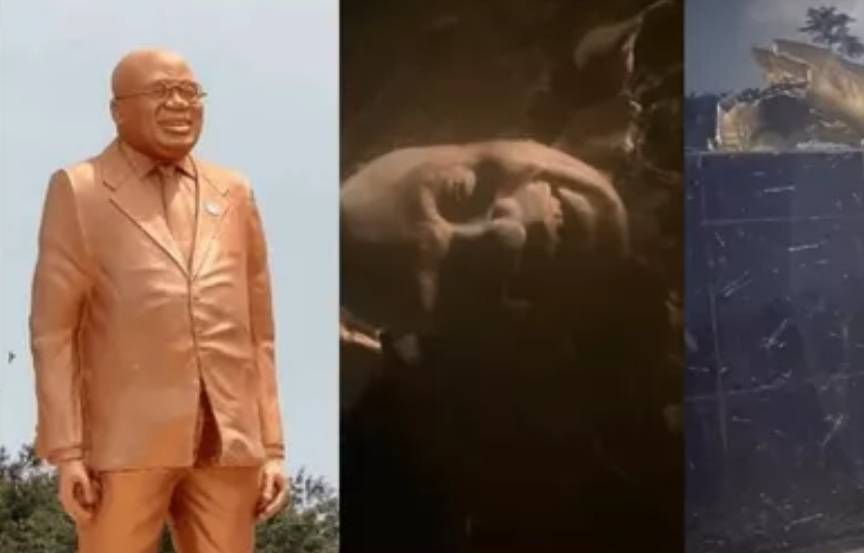A statue of Ghana’s President Nana Addo Dankwa Akufo-Addo, which once stood tall at the Effia-Nkwanta Regional Hospital roundabout in Sekondi-Takoradi, has been completely dismantled under puzzling circumstances. This has left many in the community shocked and questioning how such an event could occur. The statue, which was unveiled in November 2024, was meant to honor the president for his contributions to the region. However, it has faced both physical damage and public criticism since its installation.
On December 16, 2024, just weeks after it was unveiled, damage was discovered on the statue. A large hole had been found at the back of one of its legs, sparking widespread discussions and debates in the community. Many residents began questioning whether erecting the statue was a good use of resources. Was it necessary? Could the funds have been better spent on improving healthcare, schools, or infrastructure instead of building a monument? These were some of the issues raised at the time.
In response to the initial damage, local authorities launched investigations, and the Ghana Police Service was called upon to find the individuals responsible. Despite these efforts, no progress was made in identifying the culprits, and the mystery remained unsolved. Just as the debate was beginning to quiet down, the story took an even stranger turn.
In early January 2025, the statue was found completely dismantled. Every piece of it had been removed, leaving only an empty space where it once stood. This shocking discovery quickly became the talk of the town. Residents expressed a mix of emotions—some were outraged by what they viewed as an act of vandalism, while others felt indifferent, arguing that the statue was never needed in the first place.
The disappearance of the statue has reignited discussions about its relevance and the decision-making process behind its construction. Some residents believe that the funds used for the statue could have been better spent on addressing the challenges faced by the hospital, such as improving medical equipment, expanding facilities, or hiring more healthcare workers. Others, however, argue that the statue was a symbol of pride and respect for the region’s development under the president’s leadership.
So far, no individual or group has come forward to claim responsibility for dismantling the statue. Authorities remain silent on the matter, leaving the public to speculate about what might have happened. Was it an organized act of protest against government policies? Was it a criminal act with a completely different motive? Or was it the work of individuals simply looking to cause trouble? Without an official explanation, the mystery remains unsolved.
Beyond the act itself, the incident raises larger questions about public monuments and their purpose. What do they truly represent? Are they meant to inspire and honor, or do they sometimes create unnecessary divisions among people? For some, the statue of President Akufo-Addo was a reminder of the progress the region had made, while others viewed it as an extravagant expense that could have been avoided.
In the days following the dismantling, discussions among residents grew louder. At local markets, bus stops, and community gatherings, people shared their opinions. Some supported the removal, saying it reflected the frustrations of a community that wanted more meaningful investments. Others condemned the act, arguing that it disrespected the office of the president and the country as a whole.
This incident also puts a spotlight on the security of public spaces and properties. If a statue can be dismantled so easily, it raises concerns about how well-protected other monuments, parks, or even public buildings are. Local authorities have yet to clarify whether surveillance cameras or other security measures were in place to monitor the statue. The lack of answers only deepens the mystery surrounding this event.
As the community waits for an official statement, one thing is clear: the dismantling of the statue has left a mark far beyond its physical absence. It has sparked important conversations about the priorities of leaders, the needs of the people, and the role of monuments in representing a nation’s identity.
For now, Sekondi-Takoradi is left with an empty roundabout and a lot of unanswered questions. Will the statue be rebuilt? Will those responsible for its dismantling be caught? Or will this simply become another unsolved mystery in Ghana’s history? Only time will tell. Until then, the story of President Akufo-Addo’s statue remains a topic of curiosity, controversy, and debate.


